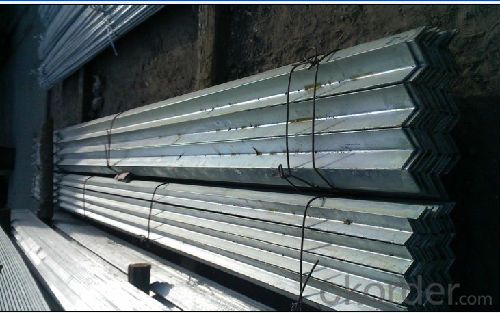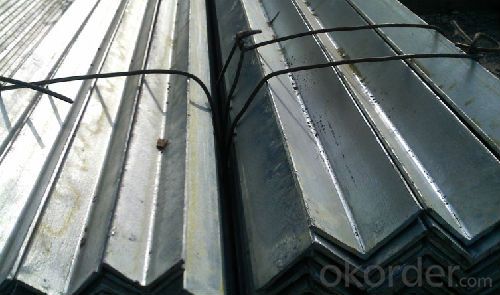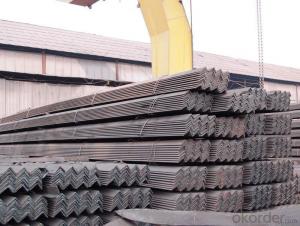Unequal Steel Angle Hot Selling Various High Quality, Angle Steel, Angle Bars
- Loading Port:
- Tianjin
- Payment Terms:
- TT or LC
- Min Order Qty:
- 28 m.t.
- Supply Capability:
- 35000 m.t./month
OKorder Service Pledge
OKorder Financial Service
You Might Also Like
Product Description:
OKorder is offering Unequal Steel Angle Hot Selling Various High Quality Angle Steel Angle Bars at great prices with worldwide shipping. Our supplier is a world-class manufacturer of steel, with our products utilized the world over. OKorder annually supplies products to European, North American and Asian markets. We provide quotations within 24 hours of receiving an inquiry and guarantee competitive prices.
Product Applications:
Unequal Steel Angle Hot Selling Various High Quality, Angle Steel, Angle Bars are ideal for structural applications and are widely used in the construction of buildings and bridges, and the manufacturing, petrochemical, and transportation industries.
Product Advantages:
OKorder's Unequal Steel Angle Hot Selling Various High Quality, Angle Steel, Angle Bars are durable, strong, and resist corrosion.
Main Product Features:
· Premium quality
· Prompt delivery & seaworthy packing (30 days after receiving deposit)
· Corrosion resistance
· Can be recycled and reused
· Mill test certification
· Professional Service
· Competitive pricing
Product Specifications:
1 .Materials:Q195/ Q235/ Q345/ ST-37/ ST-52/ SS400/ S235JR/ S275JR
2. Standard: ASTM,AISI, BS, DIN, GB, JIS
3. Type:Equal angle and Unequal
4.Size:20-200mm 75*50mm-200*100mm L:6-12m or cut as your request
| Unequal Angle | |||||||||
| Specification(mm) | Theoretical Weight(kg/m) | Specification(mm) | Theoretical Weight(kg/m) | ||||||
| 75*50*6 | 5.67 | 125*75*7 | 10.7 | ||||||
| 75*50*8 | 7.35 | 125*75*8 | 12.2 | ||||||
| 100*75*6 | 8.04 | 125*75*9 | 13.6 | ||||||
| 100*75*7 | 9.32 | 125*75*10 | 15 | ||||||
| 100*75*8 | 10.6 | 125*75*12 | 17.8 | ||||||
| 100*75*9 | 11.8 | 150*90*9 | 16.4 | ||||||
| 100*75*10 | 13 | 150*90*10 | 18.2 | ||||||
| 100*75*12 | 15.4 | 150*90*12 | 21.5 | ||||||
FAQ:
Q1: Why buy Materials & Equipment from OKorder.com?
A1: All products offered byOKorder.com are carefully selected from China's most reliable manufacturing enterprises. Through its ISO certifications, OKorder.com adheres to the highest standards and a commitment to supply chain safety and customer satisfaction.
Q2: How do we guarantee the quality of our products?
A2: We have established an advanced quality management system which conducts strict quality tests at every step, from raw materials to the final product. At the same time, we provide extensive follow-up service assurances as required.
Q3: How soon can we receive the product after purchase?
A3: Within three days of placing an order, we will begin production. The specific shipping date is dependent upon international and government factors, but is typically 7 to 10 workdays.
Q4: What makes stainless steel stainless?



- Q:What is the maximum load capacity of a steel angle?
- The maximum load capacity of a steel angle is determined by various factors including its dimensions, thickness, grade, and quality. Steel angles are generally built to withstand significant loads due to their structural characteristics. However, it is essential to refer to engineering specifications and relevant building codes to determine the specific maximum load capacity of a steel angle in a particular application. The load capacity is usually calculated by considering the angle's cross-sectional area, the material's yield strength, and the applied load factors. Furthermore, factors such as the angle's length, support conditions, and the presence of any additional reinforcement or bracing can also affect the maximum load capacity. It is vital to ensure that the steel angle is chosen, designed, and installed correctly to safely support the intended loads and comply with the necessary structural standards.
- Q:What are steel angles used for?
- Steel angles find frequent application within the construction and manufacturing sectors, serving a multitude of purposes. Structurally, steel angles serve as pivotal components. They are regularly employed as supports, braces, and reinforcements in the development of buildings, bridges, and other infrastructure endeavors. The angular shape of these steel components contributes to enhanced strength and stability, rendering them an optimal choice for the construction of load-bearing structures. The manufacturing industry also heavily relies on steel angles for the fabrication of diverse products. These angles can undergo welding, drilling, and cutting processes, allowing for the creation of bespoke shapes and structures. Commonly utilized as frames, brackets, and supports for machinery, equipment, and vehicles, steel angles aid in ensuring the stability and durability of these industrial assets. Furthermore, steel angles prove indispensable in the production of furniture, shelves, racks, and other storage solutions. Their robust construction endows them with the capability to support substantial loads, making them an ideal choice for applications in warehouses, garages, and factories. In conclusion, steel angles exhibit remarkable versatility and enjoy extensive usage in the realms of construction and manufacturing due to their inherent strength, stability, and adaptability. Whether it be supporting structures or fabricating products, these angles play a pivotal role in a myriad of applications.
- Q:Can steel angles be used for framing applications?
- Indeed, framing applications can utilize steel angles. The durability and strength of steel angles make them frequently employed in construction and framing. They offer structural support and stability for erecting walls, floors, and roofs. Furthermore, steel angles possess versatility, as they can be effortlessly welded, bolted, or screwed together to construct a robust and stable frame. Additionally, they are accessible in assorted sizes and thicknesses to cater to diverse framing necessities. All in all, due to their strength, durability, and user-friendliness, steel angles are widely favored for framing applications.
- Q:Can steel angles be used in staircases?
- Steel angles are indeed suitable for use in staircases. Due to their strength and versatility, they are commonly employed as structural components in construction. In staircases, steel angles serve to offer support and stability to both the steps and handrails. They are frequently utilized as stringers, inclined structural members that uphold the treads and risers of the staircase. Moreover, steel angles can be utilized to reinforce the connections between the treads and risers, thereby ensuring the staircase's structural integrity. Furthermore, steel angles can function as handrails or balusters, providing a secure and long-lasting railing system. All in all, steel angles present a dependable and cost-effective solution for constructing staircases that can withstand heavy loads and meet the necessary safety standards.
- Q:How do you maintain and clean steel angles?
- Steel angles can be maintained and cleaned by following a few simple steps. Start by regularly inspecting the angles for any signs of damage or corrosion. If any issues are found, address them promptly to prevent further damage. To clean the angles, begin by using a soft brush or cloth to remove any loose dirt or debris. This will prevent scratching the surface. Next, mix a mild detergent or soap with warm water and apply it to the angles using a sponge or cloth, gently scrubbing the surface. Avoid using abrasive cleaners or scrub brushes as they can harm the steel. After cleaning, rinse the angles thoroughly with clean water to remove any soap residue. Ensure that the angles are completely dry to prevent water spots or rust formation. You can use a clean cloth or towel for drying, or allow them to air dry. To maintain the steel angles, it is advisable to apply a protective coating or wax. This will help prevent corrosion and maintain their appearance. There are different types of protective coatings available, such as clear lacquers or coatings specifically designed for metal. Follow the manufacturer's instructions for application and reapplication as necessary. Additionally, it is important to avoid exposing the steel angles to harsh chemicals or environments that can accelerate corrosion. If the angles are located in an area with high humidity or saltwater exposure, regular maintenance and inspection become even more crucial. Overall, regular cleaning, inspection, and proper maintenance will ensure the longevity and appearance of steel angles.
- Q:Can steel angles be used for support columns?
- Yes, steel angles can be used for support columns. Steel angles are commonly used in construction as structural elements for providing support and stability to various building components. They are particularly suitable for use as support columns due to their strength, durability, and load-bearing capacity. Steel angles can be designed and fabricated to meet specific structural requirements, making them an ideal choice for supporting heavy loads or providing vertical support in different building applications. Additionally, steel angles offer versatility in terms of size, shape, and connection options, allowing for customized column designs that can effectively distribute loads and ensure structural integrity. Overall, steel angles are a reliable and widely used choice for support columns in various construction projects.
- Q:What is the corresponding length of the root weight in the angle standard?
- First, the classification of profiles1. simple section steelThe square - hot rolled steel, cold drawn steel; the round - rolled bar, forging round steel, cold drawn steelThe flat steel wire; 4; 5 - 6 - spring flat steel; equal angle steel, equilateral angle steel and steel triangle;The six angle to the bow; steel; elliptical steel2. complex section steelI-beam -- ordinary I-beam, light I-beamChannel steel -- hot rolled channel (ordinary channel steel, light channel steel), bent channel steelThird, H steel (also known as wide leg I-beam)Rail - heavy rail, light rail, crane rail, other special railSash steelThe steel sheet pile
- Q:What are the different types of connections used for steel angles in residential applications?
- There are several different types of connections used for steel angles in residential applications. Some of the most commonly used ones include: 1. Welded connections: This is the most common type of connection used for steel angles. It involves welding the angle to the adjacent structural members, such as beams or columns. Welded connections provide excellent strength and rigidity, making them ideal for residential applications. 2. Bolted connections: Bolted connections involve using bolts and nuts to secure the steel angle to the adjacent members. This type of connection is often used when the angle needs to be easily removable or adjustable. Bolted connections are less rigid than welded connections but still provide sufficient strength for residential applications. 3. Clip connections: Clip connections are typically used to connect steel angles to wood or other non-steel materials. They involve using clips or brackets that are attached to the angle and then fastened to the adjacent material using screws or nails. Clip connections are commonly used in residential framing applications. 4. Gusset plate connections: Gusset plate connections are used when two steel angles need to be connected at a joint. A gusset plate, which is a flat plate of steel, is welded or bolted to the angles to provide additional support and rigidity. This type of connection is often used in residential roof trusses and other structural applications. 5. Cleat connections: Cleat connections involve using a steel plate, called a cleat, that is bolted or welded to the steel angle and the adjacent member. Cleat connections are commonly used when the angle needs to be attached to a horizontal member, such as a floor or roof joist. These are just a few examples of the different types of connections used for steel angles in residential applications. The choice of connection type will depend on factors such as the structural requirements, ease of installation, and the type of materials being connected.
- Q:Can steel angles be used in modular construction?
- Yes, steel angles can indeed be used in modular construction. They are commonly used as structural elements to provide stability and support in modular buildings.
- Q:What is a steel angle?
- An angle iron, also called a steel angle or L-shaped bar, is a type of structural steel product. It consists of two legs that are joined together at a 90-degree angle. This product is widely used in the fields of construction and engineering to provide support and reinforcement to various structures. Its strength and versatility make it a preferred choice in these applications. Steel angles can be made from either carbon steel or stainless steel. They are available in different dimensions, thicknesses, and lengths to cater to different project needs. These angles can be easily cut, welded, and bolted, making them highly convenient for framing, bracing, and supporting beams, columns, and other structural components. In addition to their use in construction and engineering, steel angles are frequently employed in the manufacturing of shelves, brackets, frames, and other metalwork applications.
1. Manufacturer Overview |
|
|---|---|
| Location | |
| Year Established | |
| Annual Output Value | |
| Main Markets | |
| Company Certifications | |
2. Manufacturer Certificates |
|
|---|---|
| a) Certification Name | |
| Range | |
| Reference | |
| Validity Period | |
3. Manufacturer Capability |
|
|---|---|
| a)Trade Capacity | |
| Nearest Port | |
| Export Percentage | |
| No.of Employees in Trade Department | |
| Language Spoken: | |
| b)Factory Information | |
| Factory Size: | |
| No. of Production Lines | |
| Contract Manufacturing | |
| Product Price Range | |
Send your message to us
Unequal Steel Angle Hot Selling Various High Quality, Angle Steel, Angle Bars
- Loading Port:
- Tianjin
- Payment Terms:
- TT or LC
- Min Order Qty:
- 28 m.t.
- Supply Capability:
- 35000 m.t./month
OKorder Service Pledge
OKorder Financial Service
Similar products
New products
Hot products
Related keywords



























